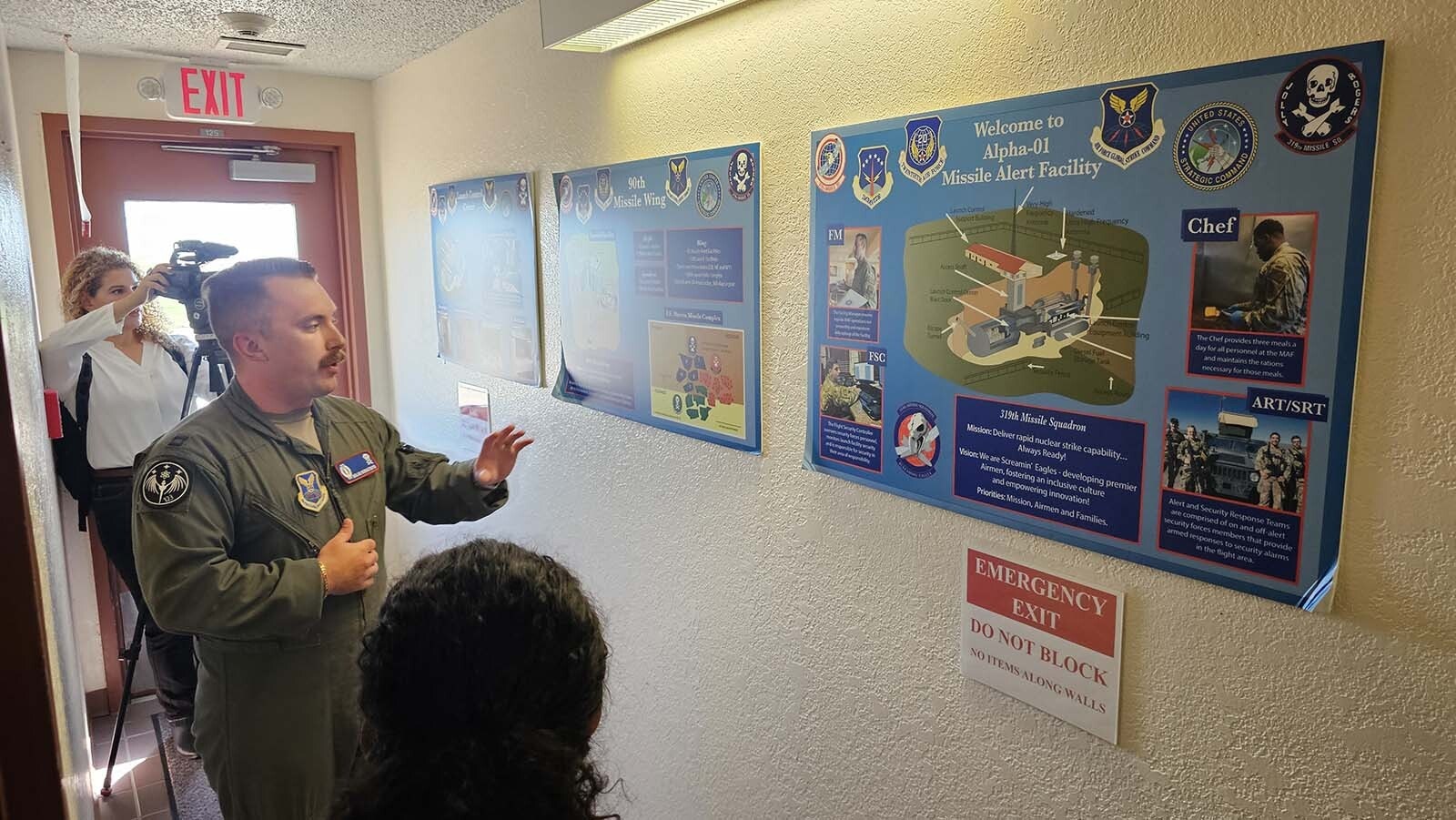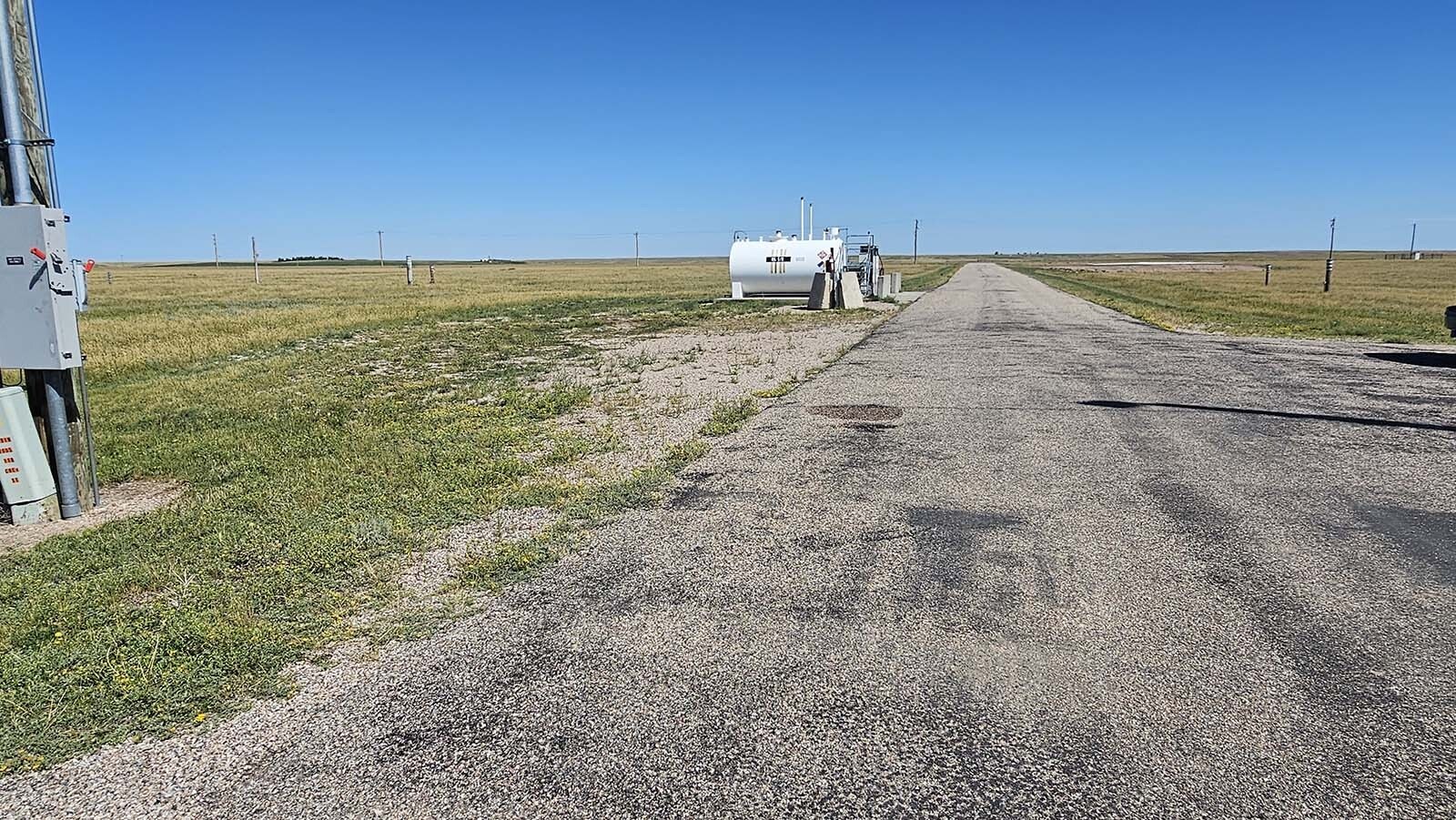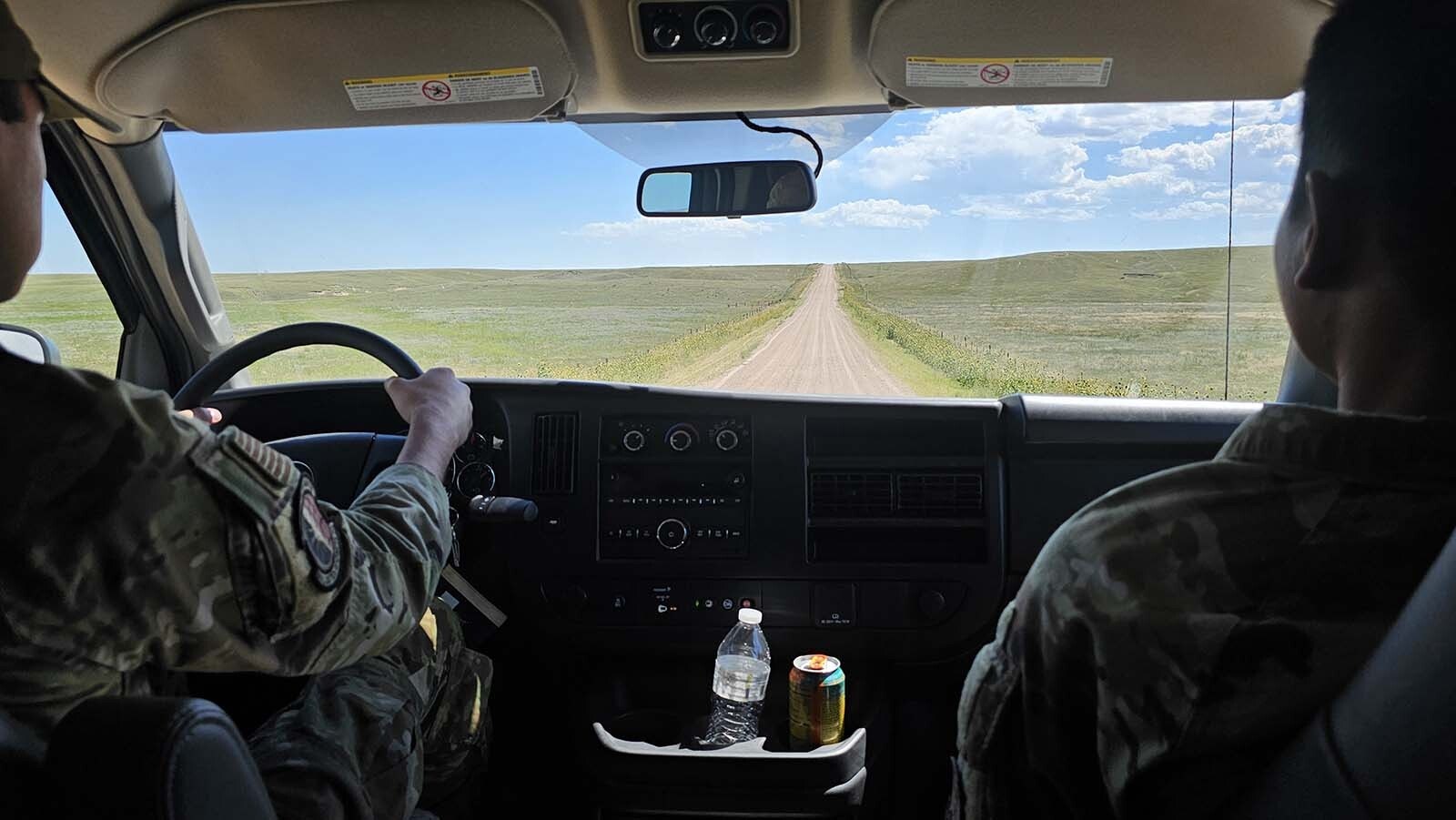The drive to F.E. Warren Air Force Base’s nearest Missile Alert Facility, home to some of the nation’s actual nuclear buttons, is long. It starts in the heart of urban Cheyenne, but becomes rural and remote far sooner than expected.
I’m on this drive with a small crew of other media on what I later learn from F.E. Warren’s former military base commander Tucker Fagan is an extremely rare opportunity to tour one of the underground capsules from which America’s missiles would be launched if they are ever needed.
These bunkers lie between 60 to 100 feet underground in chambers that have been hardened against attack.
There are no missiles in this capsule, but there’s a team of two missileers perpetually ready to take orders from the president to launch nuclear warheads at enemies who, presumably, have already launched them at us.
It’s a mission that never sleeps and has no holidays. It means having someone in all of these launch control stations around the clock, 365 days a year, ready to act on a moment’s notice.
As I look out the windows of our military van, a checkerboard of brown and green squares passes by, an ad hoc quilt pattern stitched together by a ribbon of dirt-brown gravel road.
The road is barely large enough to be a two-track in places, but it doesn’t matter. We pass no traffic and see few houses.
There’s an occasional oil well, but other than that it’s all bucolic countryside, stretching endlessly to a horizon that hovers over the literal middle of nowhere.

Making Do
The military base, when we arrive, looks incongruous in a windswept prairie of green grass.
There’s a detached garage and what looks like a ranch-style farmhouse with peeling paint, but it’s all behind a barbed wire-topped fence, like some kind of miniature prison facility.
We stop at the remote-controlled security gate and hand over our driver’s licenses for what will be the second of multiple reviews that day.
A sign to the left of the security gate identifies our location as Lindburg, Wyoming.
While we wait, I Google it, curious to know what the population might be.
Nothing comes up.
An AI summary insists there is no such town in Wyoming and suggests the spelling should be “Lindbergh” instead.
Our topside tour has few surprises. The crews manning the base work 12-hour shifts, which means some people are sleeping, and we are advised to be quiet.
We’re shown one of the dormitory-style rooms, which is smaller than what I had in college, but with no roommate.
The lounge area has a television and board games. There’s an ample kitchen where a chef prepares meals for the crew, short-order cook style.
The day’s menu has an odd bit of foreshadowing. There’s an a la carte chicken breast I buy for my garden salad. It costs $2.
That’s so cheap, I wonder what era that price would be for a restaurant. A quick Google search suggests the 1960s or 1970s — the same time frame when the first Minuteman Missile system was installed here.
While I’m ordering my salad, I overhear an officer explaining that the nearby cabinet stuffed with snacks and other miscellaneous items is a kind of on-your-honor vending machine.
There wasn’t money for a real vending machine, so they stock up a makeshift one instead.

Trespassers Beware
After lunch, we pass through the security control office where we meet Senior Airman Aaliyah James. Her counterpart wasn’t identified but is also a senior airman.
The two typically work 12-hour shifts topside, scanning between eight to 10 electronic screens for any signs of a security threat.
Signs that, so far, have never appeared.
Instead, there’s just an endless series of false alarms.
“In a week, for either days or nights, you’ll probably get at least 10 to 15 (alerts),” James said.
Most are caused by a certain gray-brown cat that has lately decided it likes to hang out there.
“He loves going to that side and sleeping,” James said. “And then you gotta go tell him, ‘You can’t sleep here, buddy.’”
The cat looks a little mangy, James said, and no one is trying to feed it.
“We did have a MAF (Missile Alert Facility) cat at one point, but he ran away,” she said. “But we’re trying to keep them away, so they don’t set off anything.”
Pest control is sometimes called to humanely take care of strays that have made themselves too much at home, Lt. Nolan Murgatroyd tells us.
The constant false alarms have long been recognized as a problem. They can contribute to a sense of complacency, and that’s why the airmen train aggressively to treat every alert the same.
“Always kitted up,” Murgatroyd said. “Always taking out armor, helmet, firearms. Always prepared to respond to the worst.”
Humans are only allowed within 25 feet of the MAF’s access road before they’re threatened with a face plant if they don’t leave.
But so far, no one has had to take any such steps. The base is remote, and there just aren’t any casual passersby.
“I’ve been out here for five years, and I’ve got over 300 alerts on my belt,” Murgatroyd said. “And I’ve never seen anything like an actual human threat.”

Of Faraday Bags …
Before we head underground, Murgatroyd reminds everyone repeatedly that we cannot take anything that emits an electronic signal with us.
It’s an issue that’s steadily become more challenging over the years, with smart devices turning up in all sorts of things.
Bluetooth sneakers, for example, which Murgatroyd admitted he owns and almost forgot about on one occasion.
But it’s all kinds of trouble if someone were to actually forget. For one thing, the rules require confiscation of the item, even if the mistake was accidental and innocent.
On that there is no leeway, Murgatroyd adds. Any such items must be put into what’s called a Faraday bag. Similar to a Faraday cage, these are gray bags about the size of a pencil case designed to block electromagnetic signals.
From there, the contraband is handed over to investigators who examine everything on the device to ensure there are no nefarious codes or signals coming from it.
All of us check and recheck our pockets to make sure we’ve got nothing that’s going to trigger this massive and inflexible protocol. Murgatroyd then leads us to the elevator that’s going to take us down to the launch control capsule.
A TARDIS Trip
The ride down the shaft to the launch control capsule feels like it would fit right in with a “Dr. Who” episode, complete with TARDIS capsule — aka the elevator car, taking us all on a journey through time.
The TARDIS capsule on “Dr. Who” was a hybrid time machine/space capsule that had a chameleon mode, so it could theoretically transform itself to blend in anywhere. Why not a military installation in Nowhere, Wyoming?
As we rode down into the earth, we saw colorful murals flash by on the walls beyond the metal gate closing us in.
Sea-like creatures, squiggled along in a turquoise ocean.
A spaceship perpetually flies into a purple flash of light that rapidly fades to black.
Strange symbols that looked incomplete flashed by as well. Some sort of secret message, perhaps. But gone too quickly to ask about.
All of the artwork is created by past missileers.
While the meaning wasn’t always clear to us, there is a history behind each and every one.
Eventually, the elevator stopped and the gate slid open. The massive blast doors had been opened wide for our visit. It all felt vaguely forbidden as we blithely stepped into the secret, underground world of the Alpha 01 Missile Alert Facility.

Welcome To The Dungeon
While the light in the elevator shaft room was bright and almost clinical, things were dark and dungeon-like a few steps beyond. This was the underground maintenance area where all the guts of the facility live.
Machines cast big, hulking shadows into every corner with inexplicable metallic purpose. There were reserve tanks for fuel and water, engines that never ever stop running, banks of power circuits, it was explained.
Reflective tape marked all the pathways to safety in the event light should ever fail in this dark place. But all of the underground systems are also doubly redundant, with a backup to the backup kind of mentality, making the actual use of such tape seem unlikely, other than for drills.
Our air was desert dry and tasted terrible, like a mixture of sweaty socks and day-old, stale bread.
The effect was courtesy of a device called a brine chiller. A medieval-sounding name, but rather than a giant torture device, it’s just a huge refrigerator system that dries the air.
A salty solution chills air below its dew point, sucking all the moisture out, before returning it.
The main purpose of this is to preserve aging computer systems.
It did mean, though, that human systems would have been grateful for a sip of water almost from the instant of arrival.
A Slowly Tilting World
Our first steps in this underground world felt very strange.
We were standing on a raised floor that looked solid, but underneath lay a shock absorption system.
Its purpose is to protect all of the underground equipment from earthquakes or attacks. But it also gave every step a little jiggle and bounce. Less than a ship or submarine, but more than enough to be noticeable and slightly disorienting.
In one corner, there were suitcases and bags casually stacked in a vaguely airport-ish feel. On one bag, though, was a label least likely to be seen at an airport: “Nuclear Decision Handbook.”
From there, we left the dark and grumbly maintenance area for a tiny cockpit-looking area where the two missileers spend their time below ground.
It looked similar to the economy section of an airplane, but shifted around like a submarine. At one point, too many people were standing on one side of the cockpit and the whole thing started to tilt ever so slowly backwards.
Some of us were then asked to shift our weight to the other side to help right things.

Let’s Do The Time Warp
It’s the cockpit that feels most like wandering into some kind of 1960s time warp. Everything in it looks vintage.
The seats look retro. They’re clearly intended to be comfortable with plenty of cushy stuffing. But there are rips and tears, and some of that stuffing is spilling out.
It’s not a fresh tear, either. The foam is that hardened orange-yellow that comes with age. Oxidation has had time to set in and darken things.
The chairs are mounted on a metal track that allows the occupants to slide back and forth in front of a series of computer screens.
The screens don’t look especially new either.
The displays seem to have three colors and look simple. We’re told these screens replaced an analog system of switches and klaxons back in the late 1990s.
Banks of turquoise racks that look like old-fashioned circuit breakers line the wall behind the two missileers. I look at some of the metallic labels on these items, searching for a date.
I don’t find one, but later after I have my phone again, I realize that some of the companies I recalled seeing there probably aren’t in business anymore.
There’s one other thing we learn no longer exists while we’re there. The infamous floppy disks are gone.
We all wanted to see the floppy disks. Much ink has been spilled in national media articles about floppy disks still in use by the missile program. Some of those articles were as recent as 2022.
Murgatroyd was the only one who remembers seeing any of them.
“We originally started with, like, 14-inch floppy disks, all the way down to the little 4-inch floppy disks,” he said. “Some equipment does have specialized SD cards, and then other equipment has what looks like a flash drive, but not a flash drive.”

The Deterrent
Launch control capsules are hardened, underground facilities where launch codes would be validated and transmitted to one or more of the 400 or so nuclear missiles the United States keeps on hair-trigger alert.
The Minutemen missiles under F.E. Warren’s control have been ready for blast-off, every second of every minute of every hour of every day for decades, in the rural fields of Wyoming, Colorado and Nebraska.
There’s no such thing as holidays or Super Bowl Sundays for these missiles, capable of delivering a nuclear strike to anywhere on the planet in roughly 30 minutes, whenever the president of the United States orders it.
Blast-off would trace a fiery arc through the sky up into space, dropping boosters at various stages. The rockets would ultimately reach speeds of 15,000 miles per hour — 65 times faster than the top speed of a Formula 1 racing car.
The payloads these missiles carry are 20 times more destructive than the atomic bombs dropped on Hiroshima and Nagasaki. The resulting, miles-long fireballs would reach millions of degrees, consuming everything within a half mile.
Shockwaves would ripple out from there, leveling structures for miles beyond that, and radioactive fallout would rain down, causing further destruction to any living thing left in its path.
If it sounds horrible, it’s the point.
It’s an outcome so bad, no country with nuclear weapons would want to trigger that outcome for themselves by using their weapons first.
It’s a tactic meant to keep everyone safer by ensuring it’s too costly to actually use nuclear weapons.
The missileers are ready to do this duty, Murgatroyd tells me when I ask if he ever thinks about these sorts of things at night.
They have trained to do that duty quickly, without thinking about it, he said.
How quickly, he won’t say.
“But it’s fast,” he added. “Very fast.”
Sleeping Underground
While the missileers don’t necessarily lose sleep thinking about the destruction sending the codes that push the proverbial nuclear button could unleash, sleep below ground is nonetheless difficult for them under the present circumstances.
Someone is awake in the cockpit area at all times, and the only thing between the resting crew partner and the awake crew partner is a thin curtain.
Alarms and alerts constantly pop off inside the cockpit at all hours of day and night. So, even though the sound of the constantly running engines in the maintenance area is blocked by the blast doors that normally seal the two in this little cockpit area, it’s definitely not a quiet space for whoever is trying to take a rest break.
“All of that adds up,” Martin said. “I just had a hearing test the other day, yesterday actually, and they were like, ‘Oh, your left ear is kind of like up and down. Your right ear is a little bit more consistent, but we’ve noticed some dips.’”
Martin and Williams have heard Sentinel’s design will look at improving this situation, which both feel is needed for those humans who do this work.
Energy drinks are popular at the MAF for a reason. Lack of sleep, lack of sunlight — it all does leave people feeling tired and drained.

Maintenance Aerobatics
The maintenance acrobatics required to keep the missile program going, given how old the system clearly is, were a bit of an opaque process to reporters on the tour.
The missileers do not handle maintenance themselves. That’s handled by specialized teams elsewhere.
“They’re the ones out there risking injury, even life, potentially, depending on what type of maintenance they’re doing, to make sure our weapon systems stay alive and we’re able to execute when necessary,” Martin said.
“The word I use is persistence,” Martin’s crew partner, Lt. Josh Williams, chimed in.
Many on the fix-it crew are young, between 18 and 21 years old, much, much younger than the systems on which they operate. But they have trained to work on each and every piece of equipment that’s associated with Minuteman III.
“If something breaks, we give them a ring, and within a couple of hours typically, especially if it’s like the generator, within couple of hours they’re out here to try and fix it,” Martin said. “They’re experts in whatever mechanical aspect or electronic aspect they’re working on.”
Many of the fix-it crews’ maintenance trips are preventive in nature, Martin added.
“They’re looking at, ‘I’m going to inspect this and get ahead of any potential problems,’” he said.
Repair Costs
The cost of repairs and updates is what’s driving replacement of Minutemen III, as well as the sense that the nation’s overall technology will be outstripped by adversaries like China and Russia without a complete overhaul of the entire nuclear triad.
While America for a period of time was trying to downsize its nuclear arsenal, other countries didn’t necessarily follow suit. Overhauling all three branches of the nuclear triad will cost close to $1 trillion.
For the land-based portion of the triad, replacement of the Minutemen III with the new LGM-35A Sentinel is going to cost an estimated $141 billion — 81% more than previous estimates. That triggered a mandatory review of the program.
As expensive as that may sound, maintenance expenses have ballooned for the existing Minutemen III to $55,000 an hour, according to a 2022 Time Magazine article. Parts, if they’re not available, have to be custom-made by a machine shop.
And while things aren’t breaking every single day, neither are broken parts uncommon.
“The system is very, very old,” Lt. Harrison Martin said, gesturing to the computer screen where the status of each missile silo is shown.
Clear means no issues, while yellow indicates some type of planned maintenance or other issue.
“It means there’s some status going on that is unexpected or that shouldn’t be happening,” Martin said. “It’s not good in a sense because when they originally designed it, it was supposed to be clean, like nothing should be there. So, when they got a yellow alarm they’d freak out back in the day.”
Many of the items are known problems, planned maintenance. It’s a preventive tack to get ahead of things before something breaks.
“That’s our day today,” Harrison said. “That’s kind of what we expect to deal with is just trying to keep this weapon system alive for the duration, until Sentinel comes online.”

When I Was A Missileer
As old as the systems are now, and as tedious as they may still seem to today’s missileers, Fagan can tell stories of when things were even worse.
“I was a crew member back in the late ’60s, early ’70s,” Fagan told me a few days after the tour. “We were in the Strategic Air Command. That’s who ran us.”
In those days, there was no cool artwork on the wall, Fagan added.
“You do something like that, and you’re a freaking mad man,” he said. “We’d never even have thought of it.”
Now that it’s allowed, however, he likes it, and sees it as a great morale booster.
“Someone who spent four and half, five years on crew or maintenance and then they get to put their name and say, ‘Hey, I had a good time, or I hated it or whatever.’ That’s cool stuff.”
When Fagan was a missileer, changing targets wasn’t a simple matter, and it couldn’t be managed remotely at all. It was a hands-on process that took days.
“Minuteman I had one weapon and to change a target, you had to get a tape from SAC (Strategic Air Command) headquarters in Omaha, fly it out here, and give it to a maintenance team,” Fagan said. “Then you had to drive it out to the missile, open the missile up — which is kind of a big deal — and then you read it in and then bring the (missile) back up on alert.”
The whole process took at least two days at its fastest, Fagan said.
“Minuteman III, you could essentially now do it from a typewriter,” Fagan said. “So, we cut out, like, two days. And we were the first wing to have it.”
F.E. Warren will still be first when Sentinel comes along. Wyoming has been scheduled to get the first of the Sentinel missiles.
The men and women who maintain the Minutemen III system every day, with all of its quirks and its time warp vibe, can’t wait.
Contact Renee Jean at renee@cowboystatedaily.com
Renée Jean can be reached at renee@cowboystatedaily.com.





